Report on Wolf Blass Winery's Strategic Plan in Turkey (MIBS6001)
VerifiedAdded on 2023/06/04
|15
|4021
|140
Report
AI Summary
This report evaluates Wolf Blass winery's strategic plan to invest in wine manufacturing in Turkey, analyzing the country's political, economic, and institutional environment. The report highlights Turkey's political stability, economic growth, and membership in the WTO, while also addressing challenges such as political tensions and corruption. It assesses political risks, including civil unrest and government policies, and examines the country's open economy, growing middle class, and need for energy. The report also covers socio-cultural forces, technological changes, trade dynamics, and legal forces influencing the business environment. Additionally, it discusses international business strategies, including international, multinational, global, and transnational approaches, and the importance of adapting to the global environment by understanding cultural, economic, legal, and political factors. The analysis provides valuable insights for Wolf Blass in making informed decisions about entering the Turkish market.
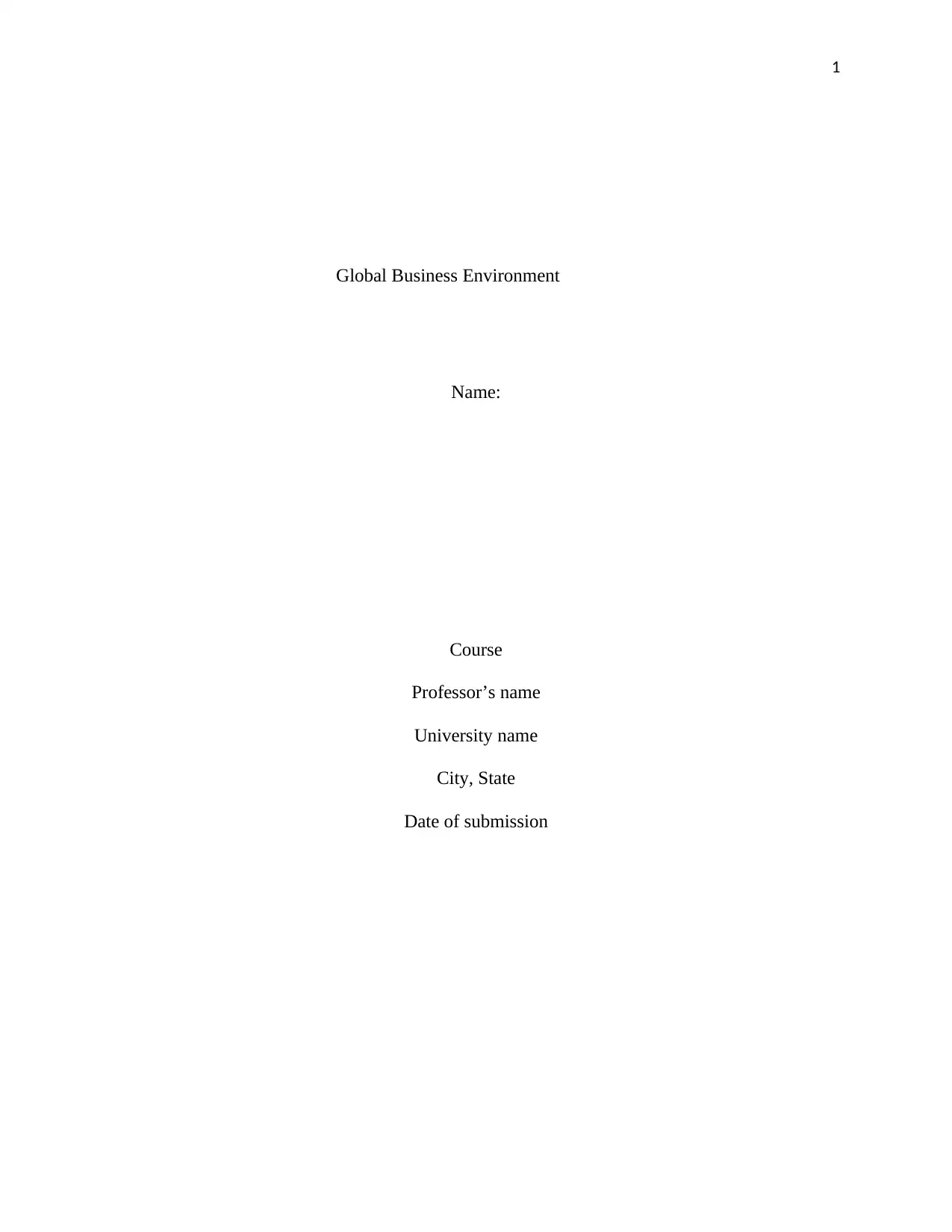
1
Global Business Environment
Name:
Course
Professor’s name
University name
City, State
Date of submission
Global Business Environment
Name:
Course
Professor’s name
University name
City, State
Date of submission
Paraphrase This Document
Need a fresh take? Get an instant paraphrase of this document with our AI Paraphraser
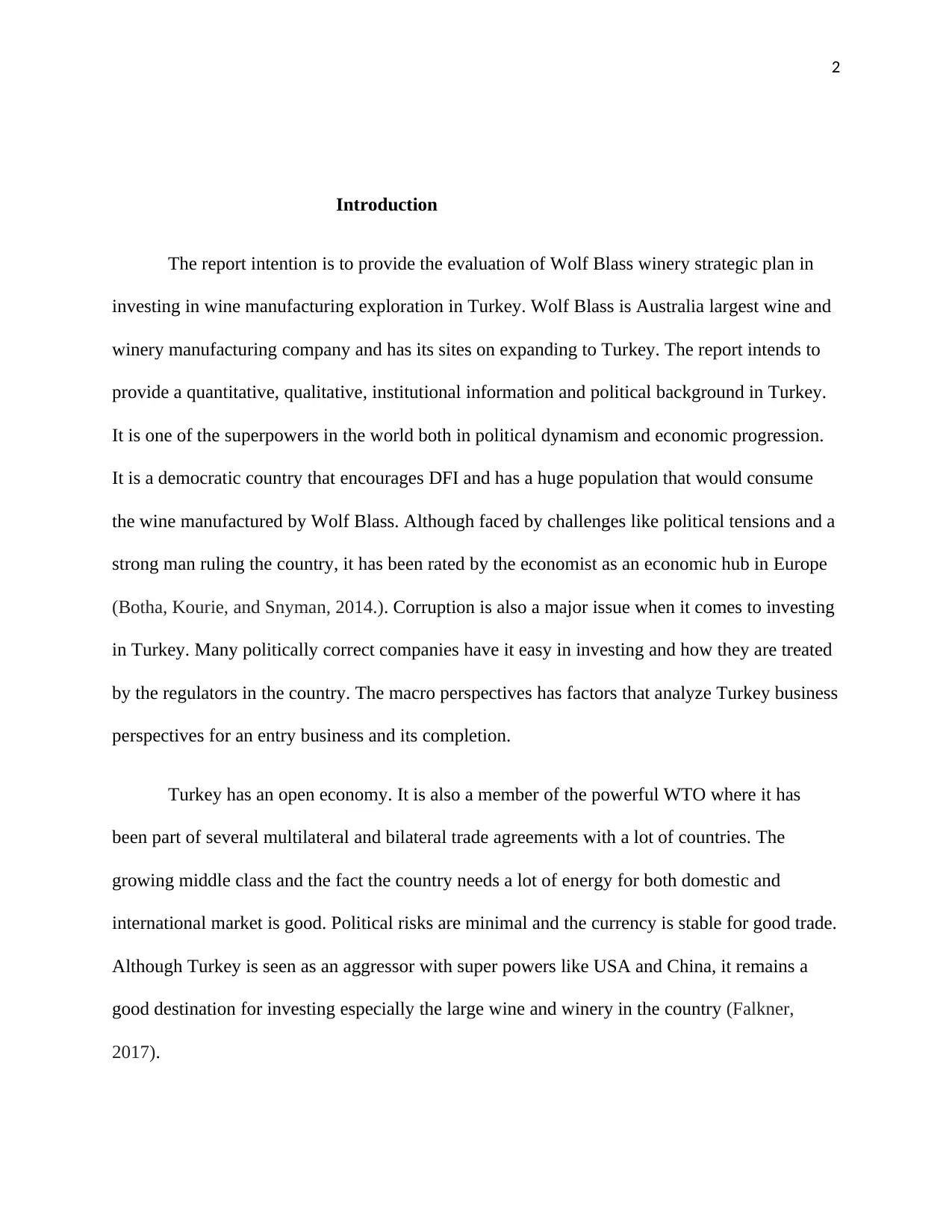
2
Introduction
The report intention is to provide the evaluation of Wolf Blass winery strategic plan in
investing in wine manufacturing exploration in Turkey. Wolf Blass is Australia largest wine and
winery manufacturing company and has its sites on expanding to Turkey. The report intends to
provide a quantitative, qualitative, institutional information and political background in Turkey.
It is one of the superpowers in the world both in political dynamism and economic progression.
It is a democratic country that encourages DFI and has a huge population that would consume
the wine manufactured by Wolf Blass. Although faced by challenges like political tensions and a
strong man ruling the country, it has been rated by the economist as an economic hub in Europe
(Botha, Kourie, and Snyman, 2014.). Corruption is also a major issue when it comes to investing
in Turkey. Many politically correct companies have it easy in investing and how they are treated
by the regulators in the country. The macro perspectives has factors that analyze Turkey business
perspectives for an entry business and its completion.
Turkey has an open economy. It is also a member of the powerful WTO where it has
been part of several multilateral and bilateral trade agreements with a lot of countries. The
growing middle class and the fact the country needs a lot of energy for both domestic and
international market is good. Political risks are minimal and the currency is stable for good trade.
Although Turkey is seen as an aggressor with super powers like USA and China, it remains a
good destination for investing especially the large wine and winery in the country (Falkner,
2017).
Introduction
The report intention is to provide the evaluation of Wolf Blass winery strategic plan in
investing in wine manufacturing exploration in Turkey. Wolf Blass is Australia largest wine and
winery manufacturing company and has its sites on expanding to Turkey. The report intends to
provide a quantitative, qualitative, institutional information and political background in Turkey.
It is one of the superpowers in the world both in political dynamism and economic progression.
It is a democratic country that encourages DFI and has a huge population that would consume
the wine manufactured by Wolf Blass. Although faced by challenges like political tensions and a
strong man ruling the country, it has been rated by the economist as an economic hub in Europe
(Botha, Kourie, and Snyman, 2014.). Corruption is also a major issue when it comes to investing
in Turkey. Many politically correct companies have it easy in investing and how they are treated
by the regulators in the country. The macro perspectives has factors that analyze Turkey business
perspectives for an entry business and its completion.
Turkey has an open economy. It is also a member of the powerful WTO where it has
been part of several multilateral and bilateral trade agreements with a lot of countries. The
growing middle class and the fact the country needs a lot of energy for both domestic and
international market is good. Political risks are minimal and the currency is stable for good trade.
Although Turkey is seen as an aggressor with super powers like USA and China, it remains a
good destination for investing especially the large wine and winery in the country (Falkner,
2017).
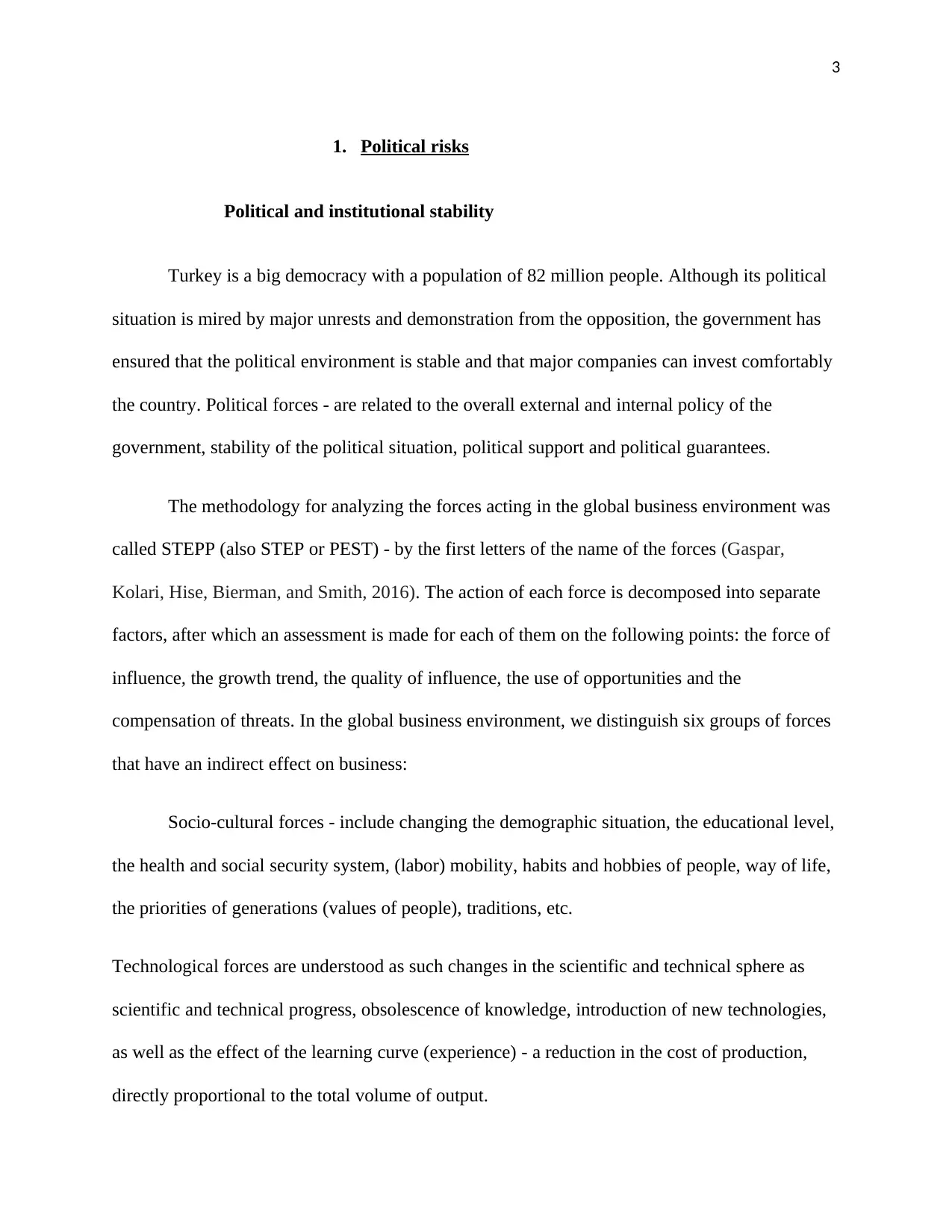
3
1. Political risks
Political and institutional stability
Turkey is a big democracy with a population of 82 million people. Although its political
situation is mired by major unrests and demonstration from the opposition, the government has
ensured that the political environment is stable and that major companies can invest comfortably
the country. Political forces - are related to the overall external and internal policy of the
government, stability of the political situation, political support and political guarantees.
The methodology for analyzing the forces acting in the global business environment was
called STEPP (also STEP or PEST) - by the first letters of the name of the forces (Gaspar,
Kolari, Hise, Bierman, and Smith, 2016). The action of each force is decomposed into separate
factors, after which an assessment is made for each of them on the following points: the force of
influence, the growth trend, the quality of influence, the use of opportunities and the
compensation of threats. In the global business environment, we distinguish six groups of forces
that have an indirect effect on business:
Socio-cultural forces - include changing the demographic situation, the educational level,
the health and social security system, (labor) mobility, habits and hobbies of people, way of life,
the priorities of generations (values of people), traditions, etc.
Technological forces are understood as such changes in the scientific and technical sphere as
scientific and technical progress, obsolescence of knowledge, introduction of new technologies,
as well as the effect of the learning curve (experience) - a reduction in the cost of production,
directly proportional to the total volume of output.
1. Political risks
Political and institutional stability
Turkey is a big democracy with a population of 82 million people. Although its political
situation is mired by major unrests and demonstration from the opposition, the government has
ensured that the political environment is stable and that major companies can invest comfortably
the country. Political forces - are related to the overall external and internal policy of the
government, stability of the political situation, political support and political guarantees.
The methodology for analyzing the forces acting in the global business environment was
called STEPP (also STEP or PEST) - by the first letters of the name of the forces (Gaspar,
Kolari, Hise, Bierman, and Smith, 2016). The action of each force is decomposed into separate
factors, after which an assessment is made for each of them on the following points: the force of
influence, the growth trend, the quality of influence, the use of opportunities and the
compensation of threats. In the global business environment, we distinguish six groups of forces
that have an indirect effect on business:
Socio-cultural forces - include changing the demographic situation, the educational level,
the health and social security system, (labor) mobility, habits and hobbies of people, way of life,
the priorities of generations (values of people), traditions, etc.
Technological forces are understood as such changes in the scientific and technical sphere as
scientific and technical progress, obsolescence of knowledge, introduction of new technologies,
as well as the effect of the learning curve (experience) - a reduction in the cost of production,
directly proportional to the total volume of output.
⊘ This is a preview!⊘
Do you want full access?
Subscribe today to unlock all pages.

Trusted by 1+ million students worldwide
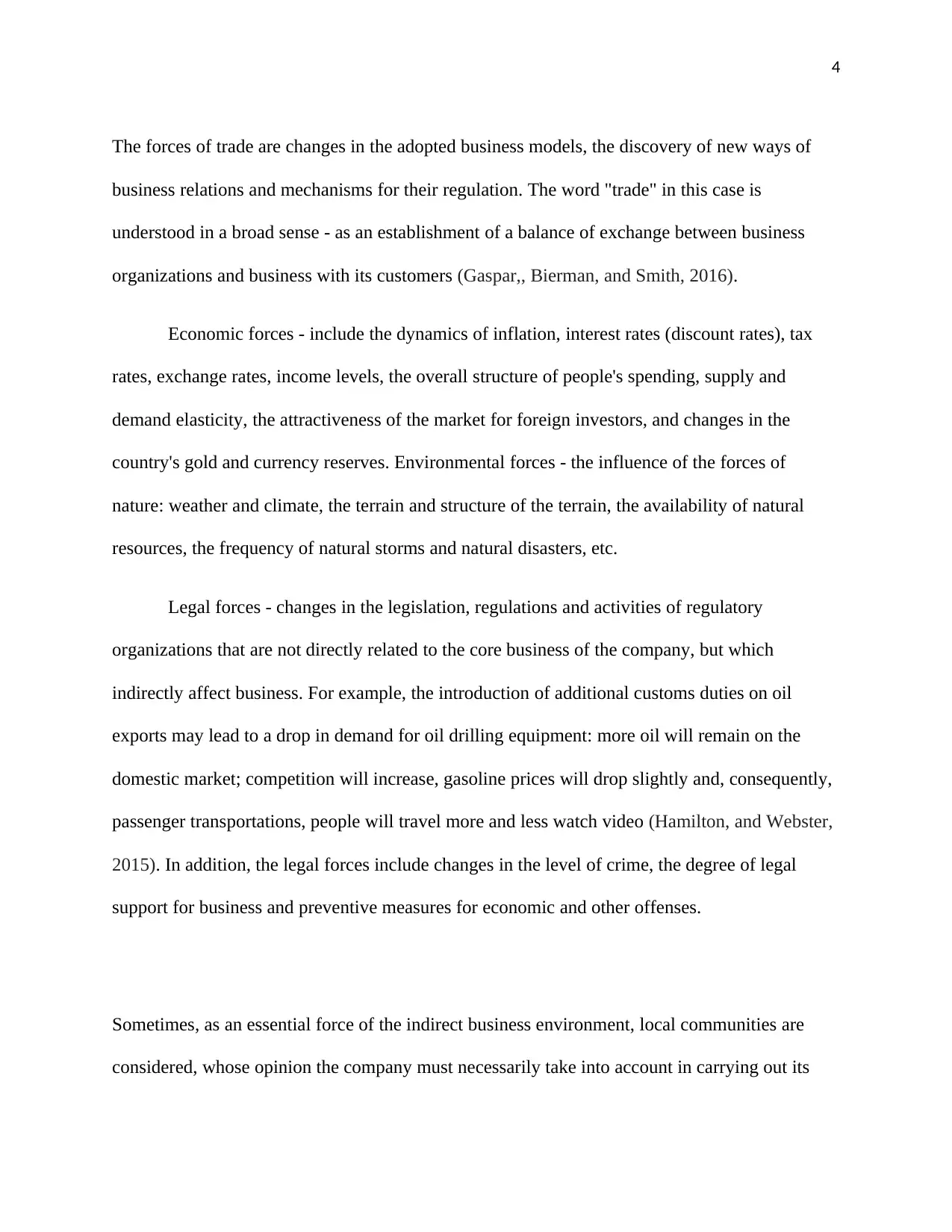
4
The forces of trade are changes in the adopted business models, the discovery of new ways of
business relations and mechanisms for their regulation. The word "trade" in this case is
understood in a broad sense - as an establishment of a balance of exchange between business
organizations and business with its customers (Gaspar,, Bierman, and Smith, 2016).
Economic forces - include the dynamics of inflation, interest rates (discount rates), tax
rates, exchange rates, income levels, the overall structure of people's spending, supply and
demand elasticity, the attractiveness of the market for foreign investors, and changes in the
country's gold and currency reserves. Environmental forces - the influence of the forces of
nature: weather and climate, the terrain and structure of the terrain, the availability of natural
resources, the frequency of natural storms and natural disasters, etc.
Legal forces - changes in the legislation, regulations and activities of regulatory
organizations that are not directly related to the core business of the company, but which
indirectly affect business. For example, the introduction of additional customs duties on oil
exports may lead to a drop in demand for oil drilling equipment: more oil will remain on the
domestic market; competition will increase, gasoline prices will drop slightly and, consequently,
passenger transportations, people will travel more and less watch video (Hamilton, and Webster,
2015). In addition, the legal forces include changes in the level of crime, the degree of legal
support for business and preventive measures for economic and other offenses.
Sometimes, as an essential force of the indirect business environment, local communities are
considered, whose opinion the company must necessarily take into account in carrying out its
The forces of trade are changes in the adopted business models, the discovery of new ways of
business relations and mechanisms for their regulation. The word "trade" in this case is
understood in a broad sense - as an establishment of a balance of exchange between business
organizations and business with its customers (Gaspar,, Bierman, and Smith, 2016).
Economic forces - include the dynamics of inflation, interest rates (discount rates), tax
rates, exchange rates, income levels, the overall structure of people's spending, supply and
demand elasticity, the attractiveness of the market for foreign investors, and changes in the
country's gold and currency reserves. Environmental forces - the influence of the forces of
nature: weather and climate, the terrain and structure of the terrain, the availability of natural
resources, the frequency of natural storms and natural disasters, etc.
Legal forces - changes in the legislation, regulations and activities of regulatory
organizations that are not directly related to the core business of the company, but which
indirectly affect business. For example, the introduction of additional customs duties on oil
exports may lead to a drop in demand for oil drilling equipment: more oil will remain on the
domestic market; competition will increase, gasoline prices will drop slightly and, consequently,
passenger transportations, people will travel more and less watch video (Hamilton, and Webster,
2015). In addition, the legal forces include changes in the level of crime, the degree of legal
support for business and preventive measures for economic and other offenses.
Sometimes, as an essential force of the indirect business environment, local communities are
considered, whose opinion the company must necessarily take into account in carrying out its
Paraphrase This Document
Need a fresh take? Get an instant paraphrase of this document with our AI Paraphraser
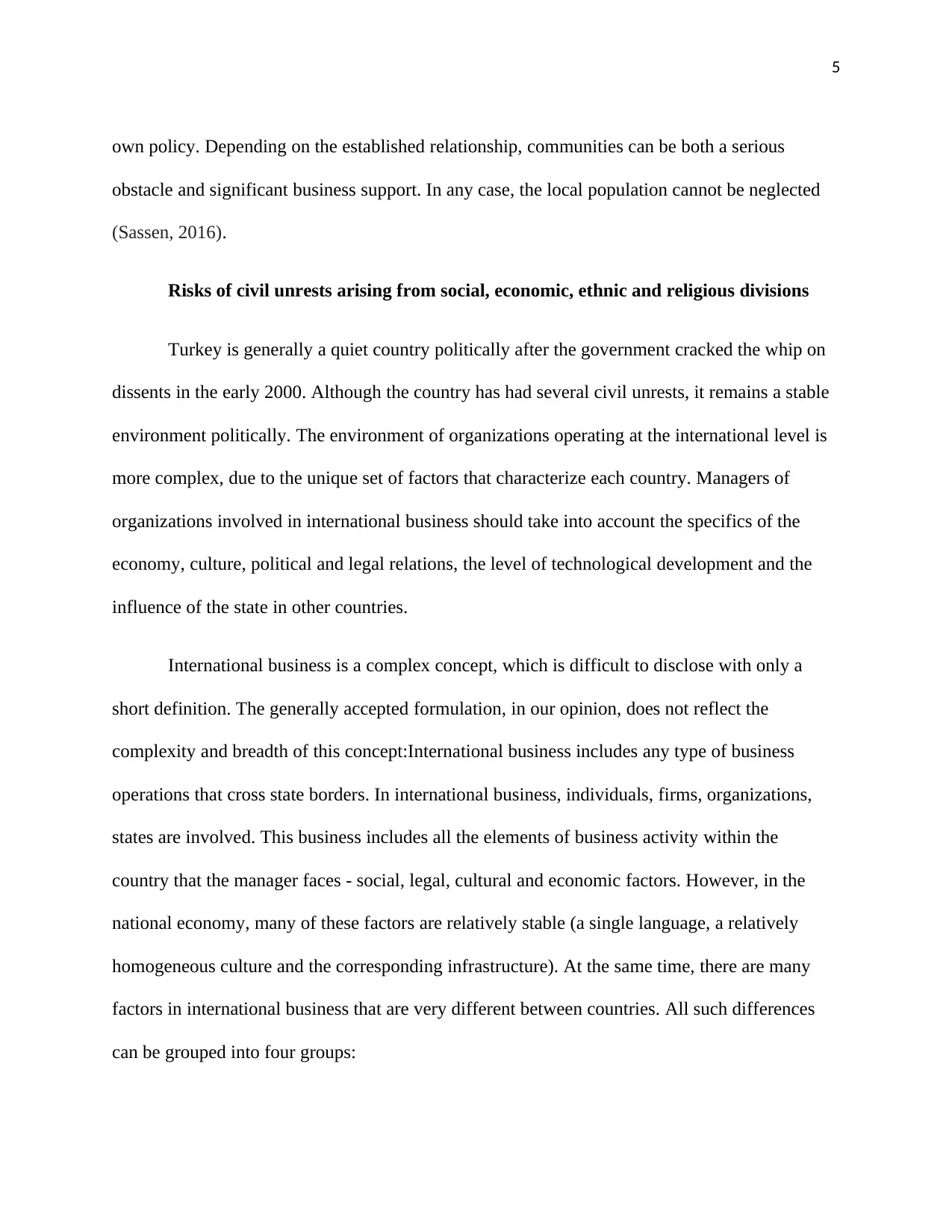
5
own policy. Depending on the established relationship, communities can be both a serious
obstacle and significant business support. In any case, the local population cannot be neglected
(Sassen, 2016).
Risks of civil unrests arising from social, economic, ethnic and religious divisions
Turkey is generally a quiet country politically after the government cracked the whip on
dissents in the early 2000. Although the country has had several civil unrests, it remains a stable
environment politically. The environment of organizations operating at the international level is
more complex, due to the unique set of factors that characterize each country. Managers of
organizations involved in international business should take into account the specifics of the
economy, culture, political and legal relations, the level of technological development and the
influence of the state in other countries.
International business is a complex concept, which is difficult to disclose with only a
short definition. The generally accepted formulation, in our opinion, does not reflect the
complexity and breadth of this concept:International business includes any type of business
operations that cross state borders. In international business, individuals, firms, organizations,
states are involved. This business includes all the elements of business activity within the
country that the manager faces - social, legal, cultural and economic factors. However, in the
national economy, many of these factors are relatively stable (a single language, a relatively
homogeneous culture and the corresponding infrastructure). At the same time, there are many
factors in international business that are very different between countries. All such differences
can be grouped into four groups:
own policy. Depending on the established relationship, communities can be both a serious
obstacle and significant business support. In any case, the local population cannot be neglected
(Sassen, 2016).
Risks of civil unrests arising from social, economic, ethnic and religious divisions
Turkey is generally a quiet country politically after the government cracked the whip on
dissents in the early 2000. Although the country has had several civil unrests, it remains a stable
environment politically. The environment of organizations operating at the international level is
more complex, due to the unique set of factors that characterize each country. Managers of
organizations involved in international business should take into account the specifics of the
economy, culture, political and legal relations, the level of technological development and the
influence of the state in other countries.
International business is a complex concept, which is difficult to disclose with only a
short definition. The generally accepted formulation, in our opinion, does not reflect the
complexity and breadth of this concept:International business includes any type of business
operations that cross state borders. In international business, individuals, firms, organizations,
states are involved. This business includes all the elements of business activity within the
country that the manager faces - social, legal, cultural and economic factors. However, in the
national economy, many of these factors are relatively stable (a single language, a relatively
homogeneous culture and the corresponding infrastructure). At the same time, there are many
factors in international business that are very different between countries. All such differences
can be grouped into four groups:
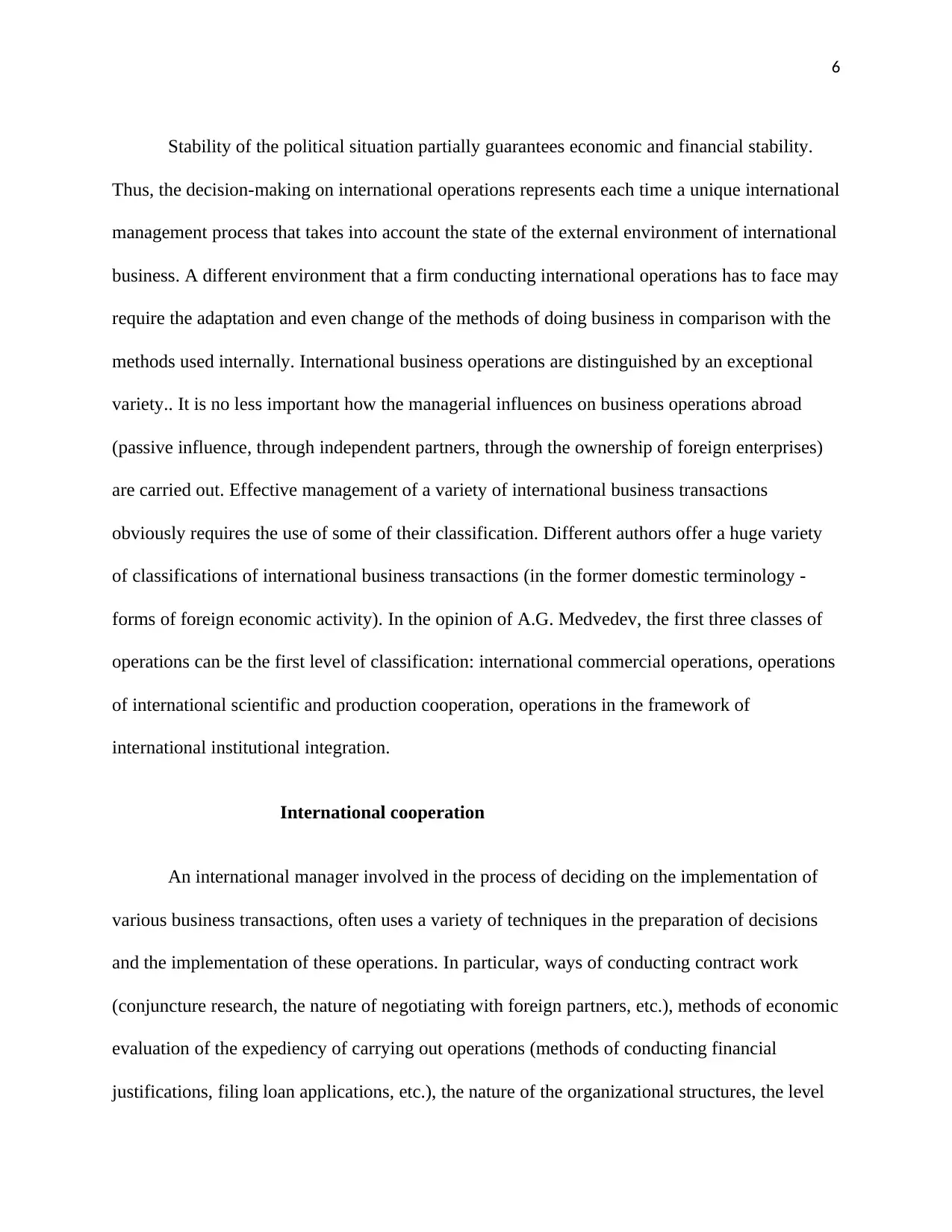
6
Stability of the political situation partially guarantees economic and financial stability.
Thus, the decision-making on international operations represents each time a unique international
management process that takes into account the state of the external environment of international
business. A different environment that a firm conducting international operations has to face may
require the adaptation and even change of the methods of doing business in comparison with the
methods used internally. International business operations are distinguished by an exceptional
variety.. It is no less important how the managerial influences on business operations abroad
(passive influence, through independent partners, through the ownership of foreign enterprises)
are carried out. Effective management of a variety of international business transactions
obviously requires the use of some of their classification. Different authors offer a huge variety
of classifications of international business transactions (in the former domestic terminology -
forms of foreign economic activity). In the opinion of A.G. Medvedev, the first three classes of
operations can be the first level of classification: international commercial operations, operations
of international scientific and production cooperation, operations in the framework of
international institutional integration.
International cooperation
An international manager involved in the process of deciding on the implementation of
various business transactions, often uses a variety of techniques in the preparation of decisions
and the implementation of these operations. In particular, ways of conducting contract work
(conjuncture research, the nature of negotiating with foreign partners, etc.), methods of economic
evaluation of the expediency of carrying out operations (methods of conducting financial
justifications, filing loan applications, etc.), the nature of the organizational structures, the level
Stability of the political situation partially guarantees economic and financial stability.
Thus, the decision-making on international operations represents each time a unique international
management process that takes into account the state of the external environment of international
business. A different environment that a firm conducting international operations has to face may
require the adaptation and even change of the methods of doing business in comparison with the
methods used internally. International business operations are distinguished by an exceptional
variety.. It is no less important how the managerial influences on business operations abroad
(passive influence, through independent partners, through the ownership of foreign enterprises)
are carried out. Effective management of a variety of international business transactions
obviously requires the use of some of their classification. Different authors offer a huge variety
of classifications of international business transactions (in the former domestic terminology -
forms of foreign economic activity). In the opinion of A.G. Medvedev, the first three classes of
operations can be the first level of classification: international commercial operations, operations
of international scientific and production cooperation, operations in the framework of
international institutional integration.
International cooperation
An international manager involved in the process of deciding on the implementation of
various business transactions, often uses a variety of techniques in the preparation of decisions
and the implementation of these operations. In particular, ways of conducting contract work
(conjuncture research, the nature of negotiating with foreign partners, etc.), methods of economic
evaluation of the expediency of carrying out operations (methods of conducting financial
justifications, filing loan applications, etc.), the nature of the organizational structures, the level
⊘ This is a preview!⊘
Do you want full access?
Subscribe today to unlock all pages.

Trusted by 1+ million students worldwide
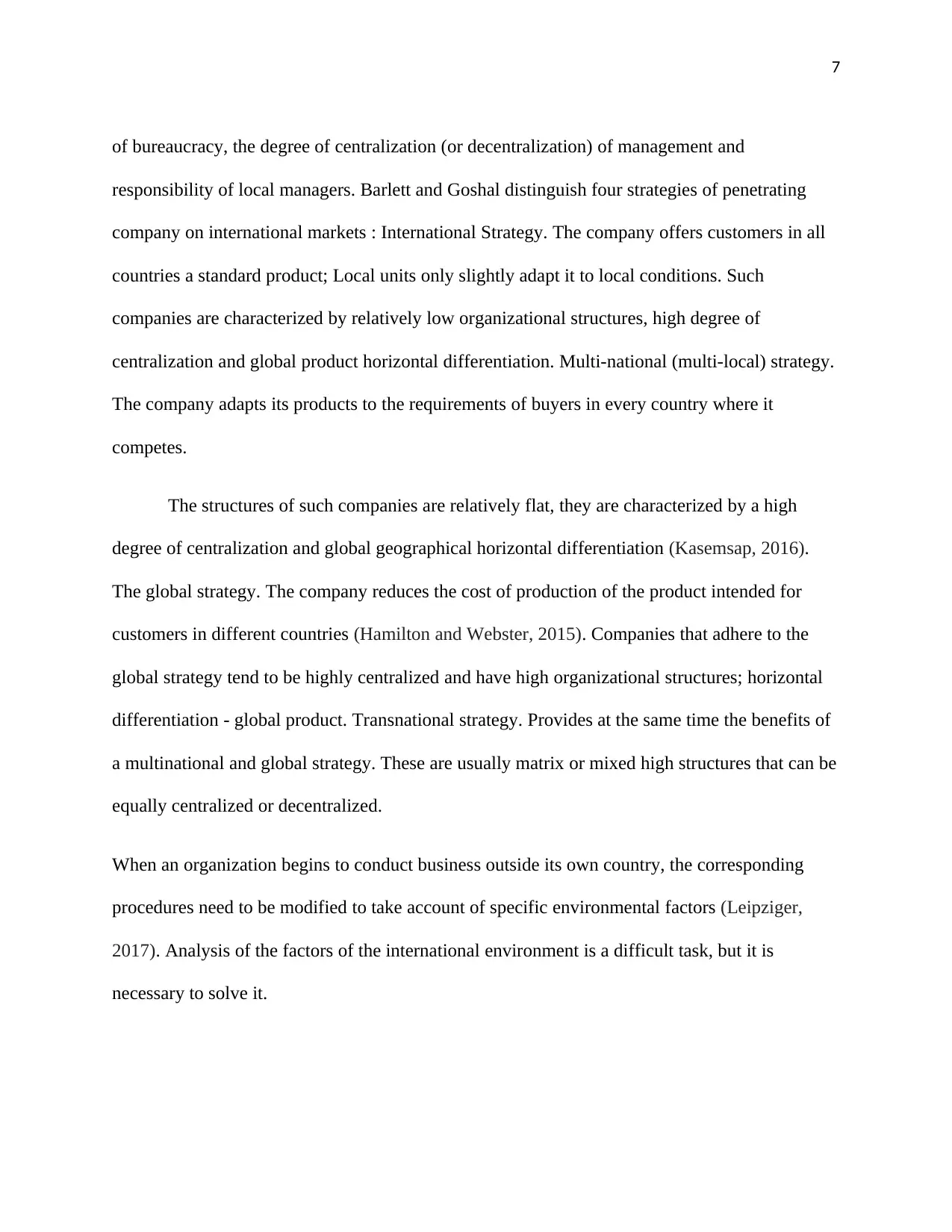
7
of bureaucracy, the degree of centralization (or decentralization) of management and
responsibility of local managers. Barlett and Goshal distinguish four strategies of penetrating
company on international markets : International Strategy. The company offers customers in all
countries a standard product; Local units only slightly adapt it to local conditions. Such
companies are characterized by relatively low organizational structures, high degree of
centralization and global product horizontal differentiation. Multi-national (multi-local) strategy.
The company adapts its products to the requirements of buyers in every country where it
competes.
The structures of such companies are relatively flat, they are characterized by a high
degree of centralization and global geographical horizontal differentiation (Kasemsap, 2016).
The global strategy. The company reduces the cost of production of the product intended for
customers in different countries (Hamilton and Webster, 2015). Companies that adhere to the
global strategy tend to be highly centralized and have high organizational structures; horizontal
differentiation - global product. Transnational strategy. Provides at the same time the benefits of
a multinational and global strategy. These are usually matrix or mixed high structures that can be
equally centralized or decentralized.
When an organization begins to conduct business outside its own country, the corresponding
procedures need to be modified to take account of specific environmental factors (Leipziger,
2017). Analysis of the factors of the international environment is a difficult task, but it is
necessary to solve it.
of bureaucracy, the degree of centralization (or decentralization) of management and
responsibility of local managers. Barlett and Goshal distinguish four strategies of penetrating
company on international markets : International Strategy. The company offers customers in all
countries a standard product; Local units only slightly adapt it to local conditions. Such
companies are characterized by relatively low organizational structures, high degree of
centralization and global product horizontal differentiation. Multi-national (multi-local) strategy.
The company adapts its products to the requirements of buyers in every country where it
competes.
The structures of such companies are relatively flat, they are characterized by a high
degree of centralization and global geographical horizontal differentiation (Kasemsap, 2016).
The global strategy. The company reduces the cost of production of the product intended for
customers in different countries (Hamilton and Webster, 2015). Companies that adhere to the
global strategy tend to be highly centralized and have high organizational structures; horizontal
differentiation - global product. Transnational strategy. Provides at the same time the benefits of
a multinational and global strategy. These are usually matrix or mixed high structures that can be
equally centralized or decentralized.
When an organization begins to conduct business outside its own country, the corresponding
procedures need to be modified to take account of specific environmental factors (Leipziger,
2017). Analysis of the factors of the international environment is a difficult task, but it is
necessary to solve it.
Paraphrase This Document
Need a fresh take? Get an instant paraphrase of this document with our AI Paraphraser
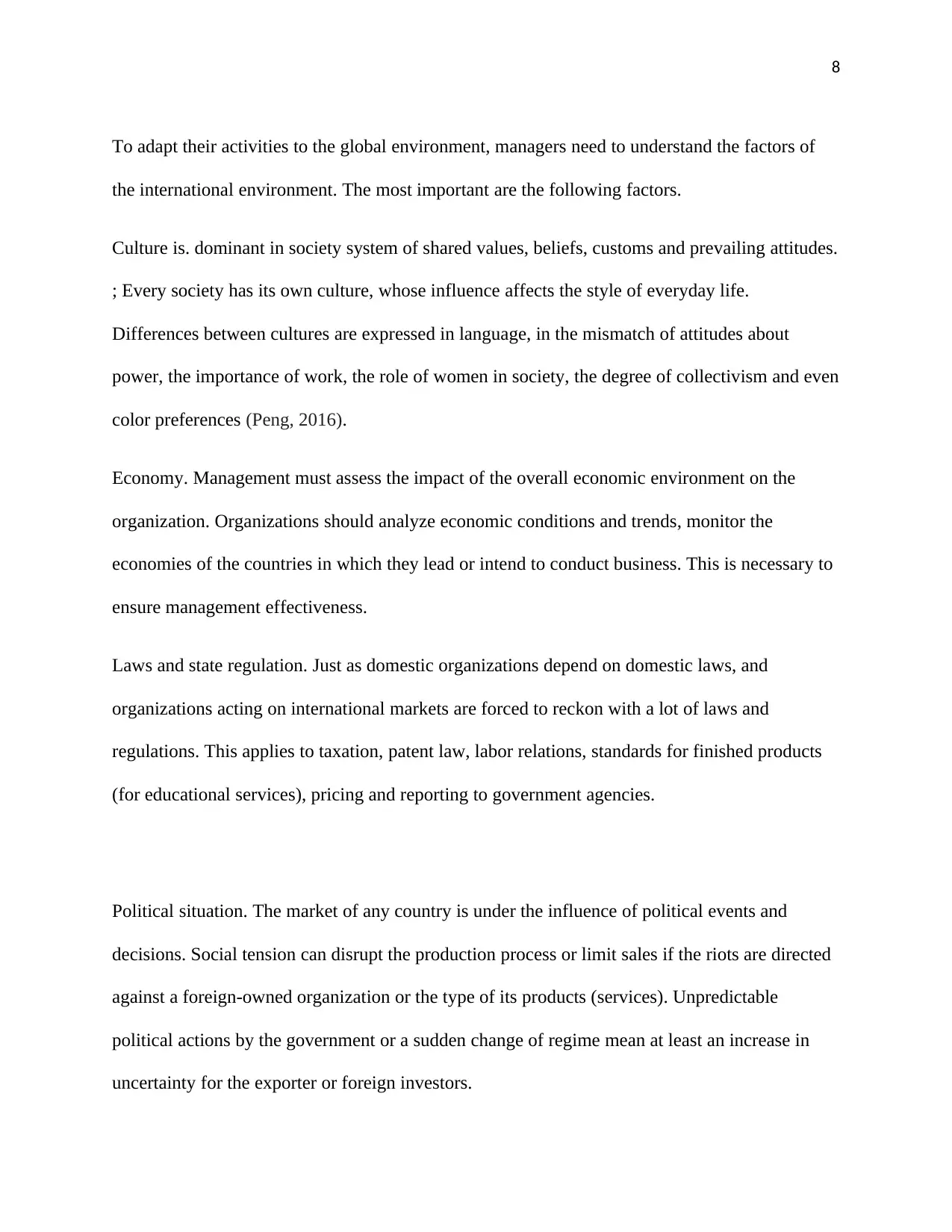
8
To adapt their activities to the global environment, managers need to understand the factors of
the international environment. The most important are the following factors.
Culture is. dominant in society system of shared values, beliefs, customs and prevailing attitudes.
; Every society has its own culture, whose influence affects the style of everyday life.
Differences between cultures are expressed in language, in the mismatch of attitudes about
power, the importance of work, the role of women in society, the degree of collectivism and even
color preferences (Peng, 2016).
Economy. Management must assess the impact of the overall economic environment on the
organization. Organizations should analyze economic conditions and trends, monitor the
economies of the countries in which they lead or intend to conduct business. This is necessary to
ensure management effectiveness.
Laws and state regulation. Just as domestic organizations depend on domestic laws, and
organizations acting on international markets are forced to reckon with a lot of laws and
regulations. This applies to taxation, patent law, labor relations, standards for finished products
(for educational services), pricing and reporting to government agencies.
Political situation. The market of any country is under the influence of political events and
decisions. Social tension can disrupt the production process or limit sales if the riots are directed
against a foreign-owned organization or the type of its products (services). Unpredictable
political actions by the government or a sudden change of regime mean at least an increase in
uncertainty for the exporter or foreign investors.
To adapt their activities to the global environment, managers need to understand the factors of
the international environment. The most important are the following factors.
Culture is. dominant in society system of shared values, beliefs, customs and prevailing attitudes.
; Every society has its own culture, whose influence affects the style of everyday life.
Differences between cultures are expressed in language, in the mismatch of attitudes about
power, the importance of work, the role of women in society, the degree of collectivism and even
color preferences (Peng, 2016).
Economy. Management must assess the impact of the overall economic environment on the
organization. Organizations should analyze economic conditions and trends, monitor the
economies of the countries in which they lead or intend to conduct business. This is necessary to
ensure management effectiveness.
Laws and state regulation. Just as domestic organizations depend on domestic laws, and
organizations acting on international markets are forced to reckon with a lot of laws and
regulations. This applies to taxation, patent law, labor relations, standards for finished products
(for educational services), pricing and reporting to government agencies.
Political situation. The market of any country is under the influence of political events and
decisions. Social tension can disrupt the production process or limit sales if the riots are directed
against a foreign-owned organization or the type of its products (services). Unpredictable
political actions by the government or a sudden change of regime mean at least an increase in
uncertainty for the exporter or foreign investors.
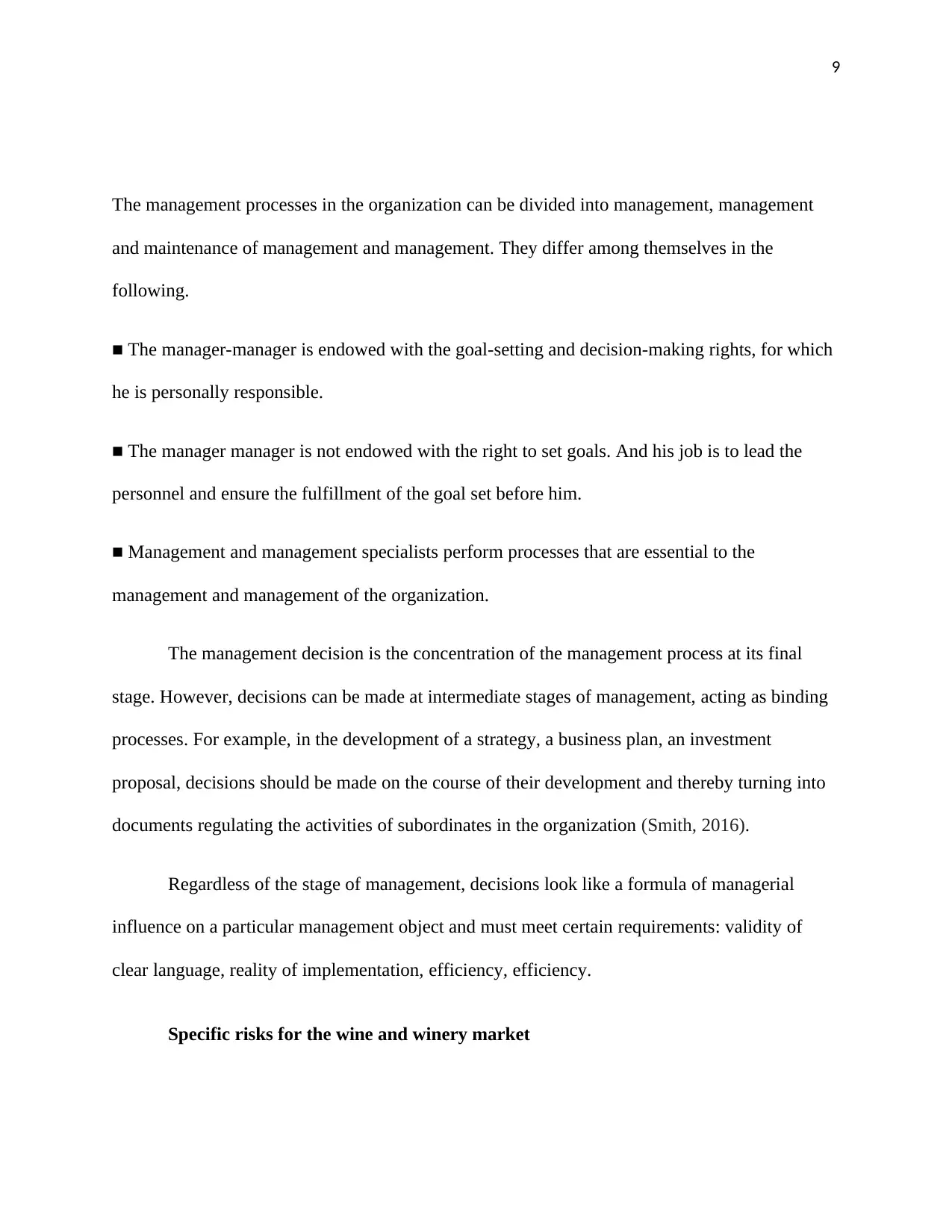
9
The management processes in the organization can be divided into management, management
and maintenance of management and management. They differ among themselves in the
following.
■ The manager-manager is endowed with the goal-setting and decision-making rights, for which
he is personally responsible.
■ The manager manager is not endowed with the right to set goals. And his job is to lead the
personnel and ensure the fulfillment of the goal set before him.
■ Management and management specialists perform processes that are essential to the
management and management of the organization.
The management decision is the concentration of the management process at its final
stage. However, decisions can be made at intermediate stages of management, acting as binding
processes. For example, in the development of a strategy, a business plan, an investment
proposal, decisions should be made on the course of their development and thereby turning into
documents regulating the activities of subordinates in the organization (Smith, 2016).
Regardless of the stage of management, decisions look like a formula of managerial
influence on a particular management object and must meet certain requirements: validity of
clear language, reality of implementation, efficiency, efficiency.
Specific risks for the wine and winery market
The management processes in the organization can be divided into management, management
and maintenance of management and management. They differ among themselves in the
following.
■ The manager-manager is endowed with the goal-setting and decision-making rights, for which
he is personally responsible.
■ The manager manager is not endowed with the right to set goals. And his job is to lead the
personnel and ensure the fulfillment of the goal set before him.
■ Management and management specialists perform processes that are essential to the
management and management of the organization.
The management decision is the concentration of the management process at its final
stage. However, decisions can be made at intermediate stages of management, acting as binding
processes. For example, in the development of a strategy, a business plan, an investment
proposal, decisions should be made on the course of their development and thereby turning into
documents regulating the activities of subordinates in the organization (Smith, 2016).
Regardless of the stage of management, decisions look like a formula of managerial
influence on a particular management object and must meet certain requirements: validity of
clear language, reality of implementation, efficiency, efficiency.
Specific risks for the wine and winery market
⊘ This is a preview!⊘
Do you want full access?
Subscribe today to unlock all pages.

Trusted by 1+ million students worldwide
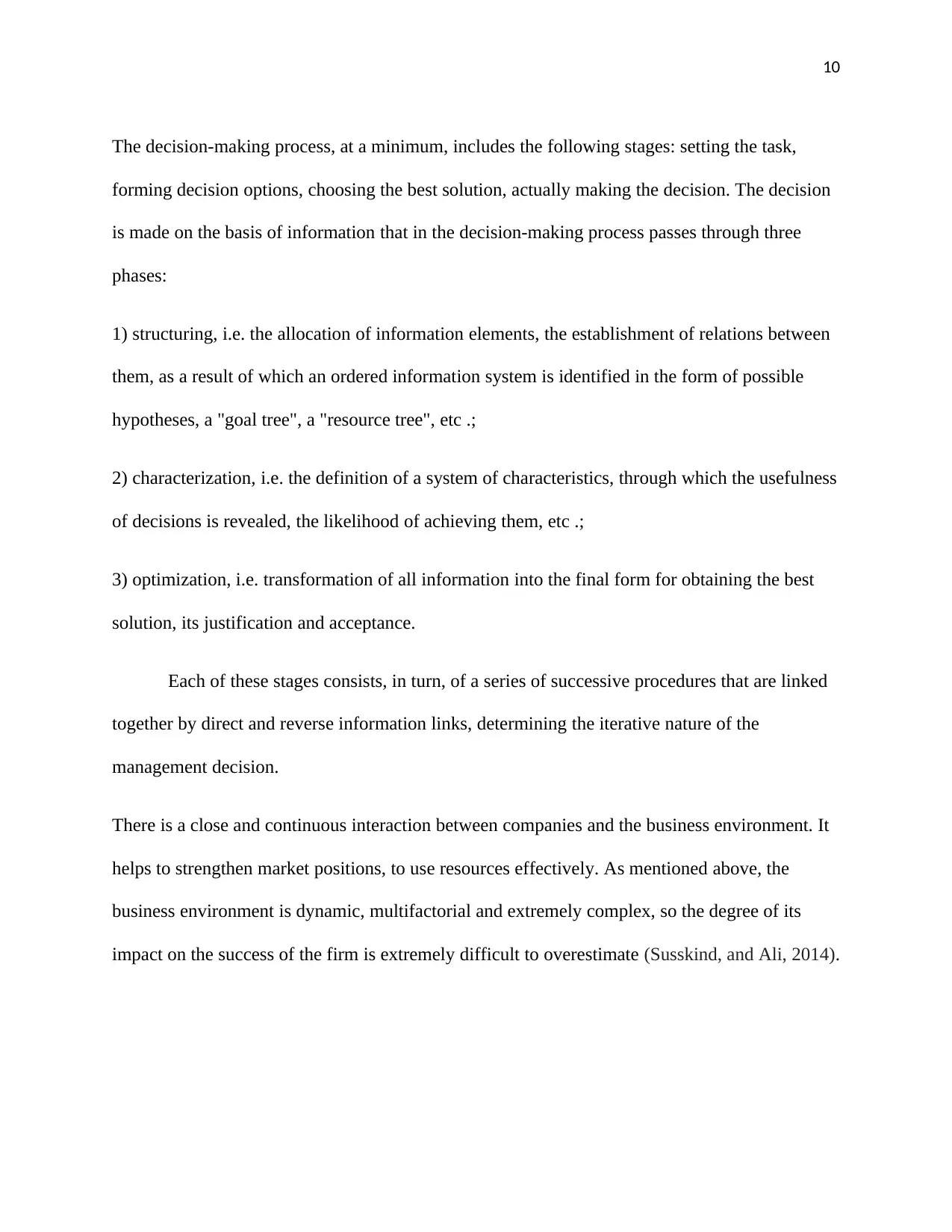
10
The decision-making process, at a minimum, includes the following stages: setting the task,
forming decision options, choosing the best solution, actually making the decision. The decision
is made on the basis of information that in the decision-making process passes through three
phases:
1) structuring, i.e. the allocation of information elements, the establishment of relations between
them, as a result of which an ordered information system is identified in the form of possible
hypotheses, a "goal tree", a "resource tree", etc .;
2) characterization, i.e. the definition of a system of characteristics, through which the usefulness
of decisions is revealed, the likelihood of achieving them, etc .;
3) optimization, i.e. transformation of all information into the final form for obtaining the best
solution, its justification and acceptance.
Each of these stages consists, in turn, of a series of successive procedures that are linked
together by direct and reverse information links, determining the iterative nature of the
management decision.
There is a close and continuous interaction between companies and the business environment. It
helps to strengthen market positions, to use resources effectively. As mentioned above, the
business environment is dynamic, multifactorial and extremely complex, so the degree of its
impact on the success of the firm is extremely difficult to overestimate (Susskind, and Ali, 2014).
The decision-making process, at a minimum, includes the following stages: setting the task,
forming decision options, choosing the best solution, actually making the decision. The decision
is made on the basis of information that in the decision-making process passes through three
phases:
1) structuring, i.e. the allocation of information elements, the establishment of relations between
them, as a result of which an ordered information system is identified in the form of possible
hypotheses, a "goal tree", a "resource tree", etc .;
2) characterization, i.e. the definition of a system of characteristics, through which the usefulness
of decisions is revealed, the likelihood of achieving them, etc .;
3) optimization, i.e. transformation of all information into the final form for obtaining the best
solution, its justification and acceptance.
Each of these stages consists, in turn, of a series of successive procedures that are linked
together by direct and reverse information links, determining the iterative nature of the
management decision.
There is a close and continuous interaction between companies and the business environment. It
helps to strengthen market positions, to use resources effectively. As mentioned above, the
business environment is dynamic, multifactorial and extremely complex, so the degree of its
impact on the success of the firm is extremely difficult to overestimate (Susskind, and Ali, 2014).
Paraphrase This Document
Need a fresh take? Get an instant paraphrase of this document with our AI Paraphraser
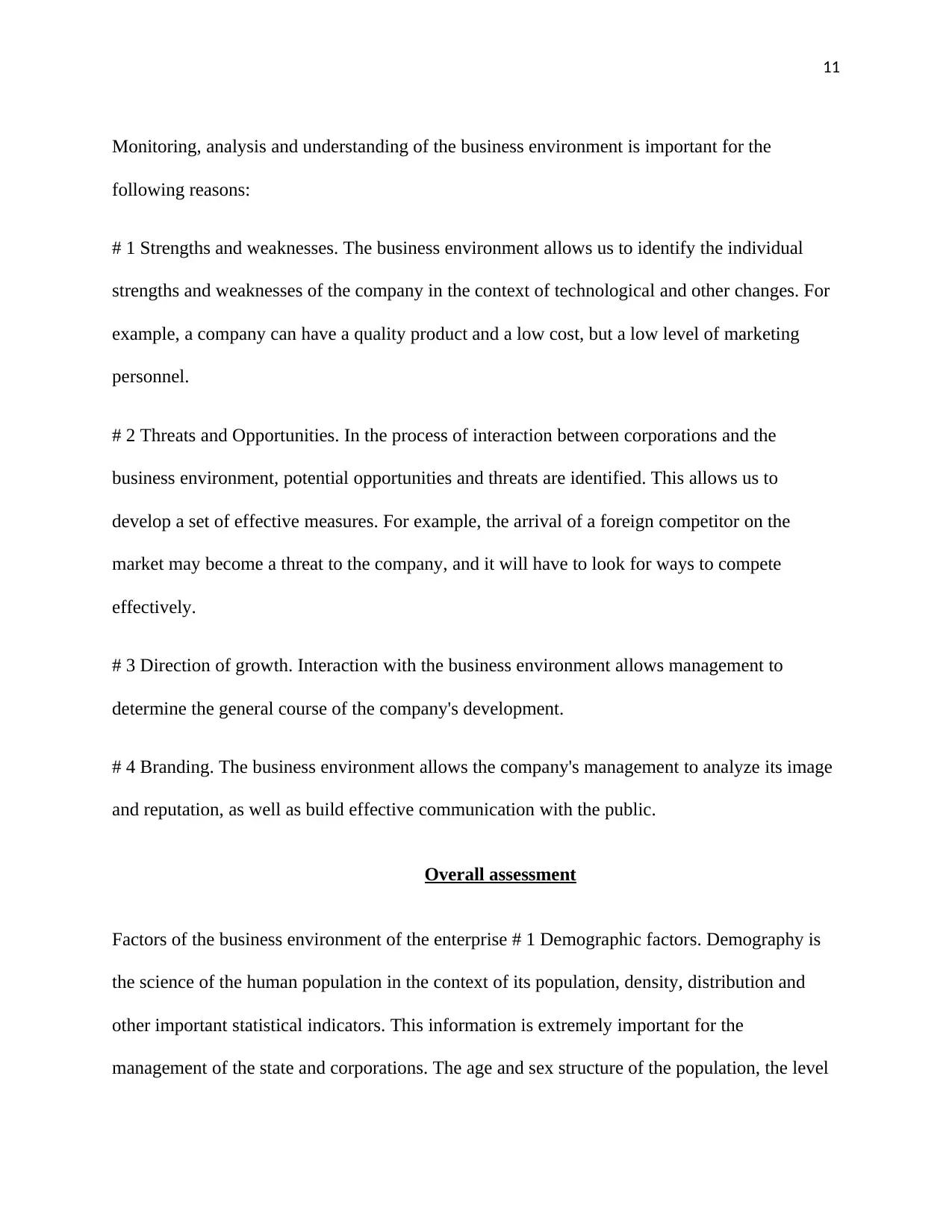
11
Monitoring, analysis and understanding of the business environment is important for the
following reasons:
# 1 Strengths and weaknesses. The business environment allows us to identify the individual
strengths and weaknesses of the company in the context of technological and other changes. For
example, a company can have a quality product and a low cost, but a low level of marketing
personnel.
# 2 Threats and Opportunities. In the process of interaction between corporations and the
business environment, potential opportunities and threats are identified. This allows us to
develop a set of effective measures. For example, the arrival of a foreign competitor on the
market may become a threat to the company, and it will have to look for ways to compete
effectively.
# 3 Direction of growth. Interaction with the business environment allows management to
determine the general course of the company's development.
# 4 Branding. The business environment allows the company's management to analyze its image
and reputation, as well as build effective communication with the public.
Overall assessment
Factors of the business environment of the enterprise # 1 Demographic factors. Demography is
the science of the human population in the context of its population, density, distribution and
other important statistical indicators. This information is extremely important for the
management of the state and corporations. The age and sex structure of the population, the level
Monitoring, analysis and understanding of the business environment is important for the
following reasons:
# 1 Strengths and weaknesses. The business environment allows us to identify the individual
strengths and weaknesses of the company in the context of technological and other changes. For
example, a company can have a quality product and a low cost, but a low level of marketing
personnel.
# 2 Threats and Opportunities. In the process of interaction between corporations and the
business environment, potential opportunities and threats are identified. This allows us to
develop a set of effective measures. For example, the arrival of a foreign competitor on the
market may become a threat to the company, and it will have to look for ways to compete
effectively.
# 3 Direction of growth. Interaction with the business environment allows management to
determine the general course of the company's development.
# 4 Branding. The business environment allows the company's management to analyze its image
and reputation, as well as build effective communication with the public.
Overall assessment
Factors of the business environment of the enterprise # 1 Demographic factors. Demography is
the science of the human population in the context of its population, density, distribution and
other important statistical indicators. This information is extremely important for the
management of the state and corporations. The age and sex structure of the population, the level
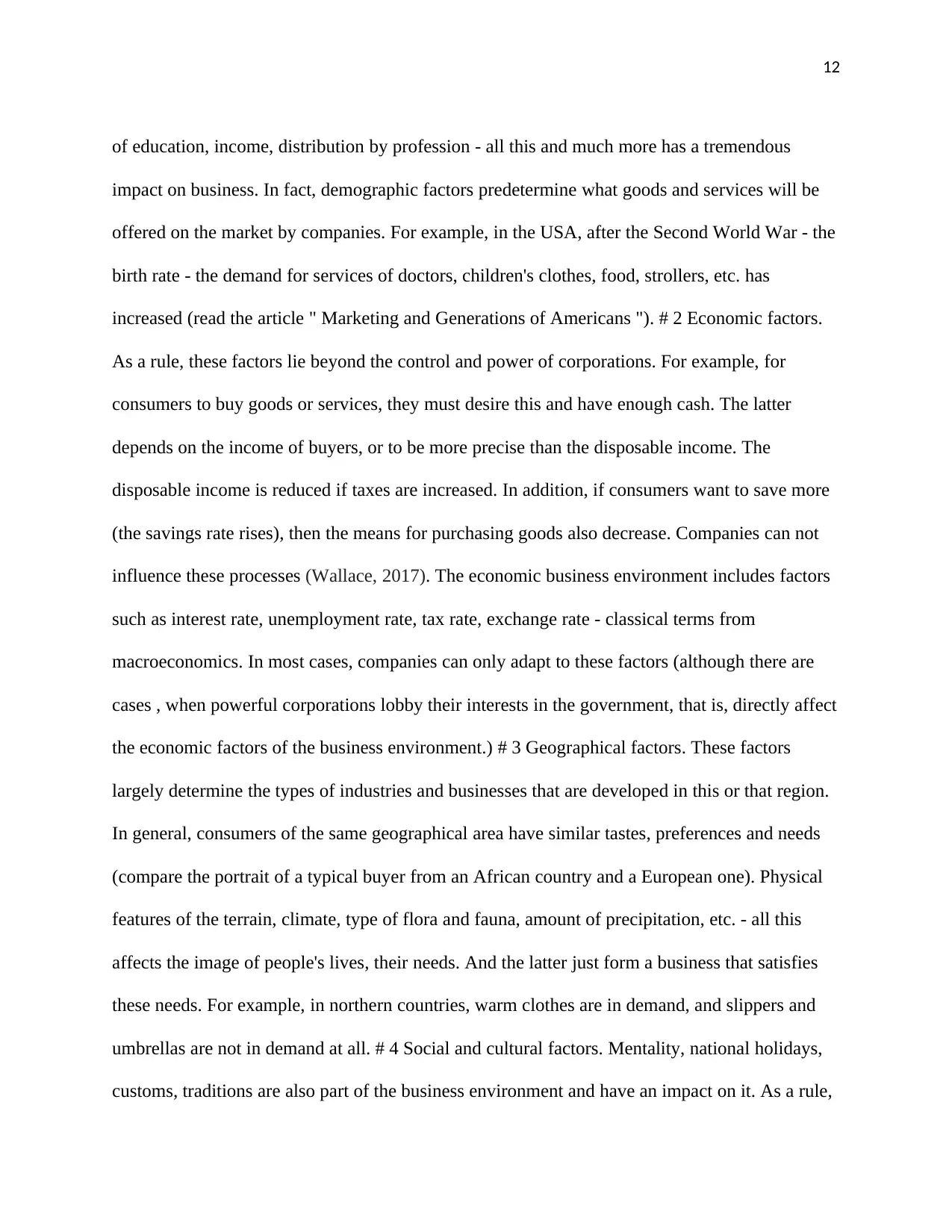
12
of education, income, distribution by profession - all this and much more has a tremendous
impact on business. In fact, demographic factors predetermine what goods and services will be
offered on the market by companies. For example, in the USA, after the Second World War - the
birth rate - the demand for services of doctors, children's clothes, food, strollers, etc. has
increased (read the article " Marketing and Generations of Americans "). # 2 Economic factors.
As a rule, these factors lie beyond the control and power of corporations. For example, for
consumers to buy goods or services, they must desire this and have enough cash. The latter
depends on the income of buyers, or to be more precise than the disposable income. The
disposable income is reduced if taxes are increased. In addition, if consumers want to save more
(the savings rate rises), then the means for purchasing goods also decrease. Companies can not
influence these processes (Wallace, 2017). The economic business environment includes factors
such as interest rate, unemployment rate, tax rate, exchange rate - classical terms from
macroeconomics. In most cases, companies can only adapt to these factors (although there are
cases , when powerful corporations lobby their interests in the government, that is, directly affect
the economic factors of the business environment.) # 3 Geographical factors. These factors
largely determine the types of industries and businesses that are developed in this or that region.
In general, consumers of the same geographical area have similar tastes, preferences and needs
(compare the portrait of a typical buyer from an African country and a European one). Physical
features of the terrain, climate, type of flora and fauna, amount of precipitation, etc. - all this
affects the image of people's lives, their needs. And the latter just form a business that satisfies
these needs. For example, in northern countries, warm clothes are in demand, and slippers and
umbrellas are not in demand at all. # 4 Social and cultural factors. Mentality, national holidays,
customs, traditions are also part of the business environment and have an impact on it. As a rule,
of education, income, distribution by profession - all this and much more has a tremendous
impact on business. In fact, demographic factors predetermine what goods and services will be
offered on the market by companies. For example, in the USA, after the Second World War - the
birth rate - the demand for services of doctors, children's clothes, food, strollers, etc. has
increased (read the article " Marketing and Generations of Americans "). # 2 Economic factors.
As a rule, these factors lie beyond the control and power of corporations. For example, for
consumers to buy goods or services, they must desire this and have enough cash. The latter
depends on the income of buyers, or to be more precise than the disposable income. The
disposable income is reduced if taxes are increased. In addition, if consumers want to save more
(the savings rate rises), then the means for purchasing goods also decrease. Companies can not
influence these processes (Wallace, 2017). The economic business environment includes factors
such as interest rate, unemployment rate, tax rate, exchange rate - classical terms from
macroeconomics. In most cases, companies can only adapt to these factors (although there are
cases , when powerful corporations lobby their interests in the government, that is, directly affect
the economic factors of the business environment.) # 3 Geographical factors. These factors
largely determine the types of industries and businesses that are developed in this or that region.
In general, consumers of the same geographical area have similar tastes, preferences and needs
(compare the portrait of a typical buyer from an African country and a European one). Physical
features of the terrain, climate, type of flora and fauna, amount of precipitation, etc. - all this
affects the image of people's lives, their needs. And the latter just form a business that satisfies
these needs. For example, in northern countries, warm clothes are in demand, and slippers and
umbrellas are not in demand at all. # 4 Social and cultural factors. Mentality, national holidays,
customs, traditions are also part of the business environment and have an impact on it. As a rule,
⊘ This is a preview!⊘
Do you want full access?
Subscribe today to unlock all pages.

Trusted by 1+ million students worldwide
1 out of 15
Related Documents
Your All-in-One AI-Powered Toolkit for Academic Success.
+13062052269
info@desklib.com
Available 24*7 on WhatsApp / Email
![[object Object]](/_next/static/media/star-bottom.7253800d.svg)
Unlock your academic potential
Copyright © 2020–2025 A2Z Services. All Rights Reserved. Developed and managed by ZUCOL.




